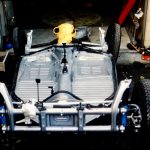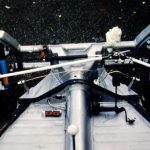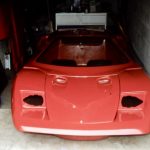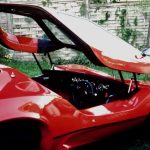PHILIP COLES’ NOVA STORY
Totalkitcar.com reader, Philip Coles brings us a lovely little build story dating back to the early eighties about the Nova that he built in the early eighties Here, he tells the sorry of his build and shares some beautiful 40-year-old photos with us. Over to you, Philip.
The Nova, designed by Richard Oakes, possessed a unique styling for its time and I think the body shape still grabs attention today.
I started building my Nova in the early eighties and at the time I was a post-graduate student, so for me, it was always a very relaxing way to spend my downtime. The build was done in a very small lock-up; fortunately, I was able to borrow a neighbour’s garage as well, so I used one for storage of bits and one for building the car.
My build was based upon a 1300S VW Beetle that had the useful addition of disc brakes. I lowered the floorpan to get some much-needed headroom for the occupants. It was either that or driving with the sunroof open … not a good option!
Most Novas at the time used the standard Beetle engine but I didn’t feel that this was in keeping with the looks of the car and so I fitted a Ford 1600cc crossflow instead. I’m not sure if it was the only Nova to be built with a Ford engine but I didn’t come across another one at the time nor have I noticed one since (editor’s note: I suspect that Dave Peace, co-founder of kitcar manufacturer, Carlton Automotive had a Ford-powered one built and also Don Law built such an example, I think).
The Ford engine fitted was mounted in the reverse configuration as used in a Formula Ford FF1600 single-seater. To successfully marry the engine and gearbox required a custom conversion plate and an extended main driveshaft from the gearbox to the flywheel of the engine.
This arrangement left the engine hanging precariously on the gearbox and mating plate. I fabricated some extension bars which screwed into the Beetle chassis frame fork. They in turn held brackets that were secured to the Ford engine mounts. This made the structure much more solid.
The engine now needed some cooling. I modified two heater radiators and fitted these in the nosecone forward of the front wheels. The Nova’s design had a front aperture that could then be opened up to duct air through the radiators.
With the help of a couple of electric fans, the system worked well. Many metres of central heating pipe were then run back to the engine bay and a small header tank was fitted in order to fill the system.
I used a very smart (for the time) four-into-one free-flow exhaust manifold, beautifully painted white and fabricated a new section to mate up with the exhaust silencer box. The manifold didn’t stay white for long!
The most distinctive feature of the Nova was, of course, the distinctive lifting roof. As all other owners will testify it always caused a show when you stopped for fuel (it was a good conversation starter though).
The roof was lifted by using an electric motor driving a hydraulic pump to operate a pair of hydraulic rams. The roof opening and closing were activated by an external bi-directional key switch. This switch was really the door lock for the whole car. No one was going to get in without lifting that roof.
I completely changed the inside of the car from what Richard Oakes had planned. His design used a couple of pods for switches and instrumentation. By contrast, I created and built a wrap-around one-piece dashboard unit, that was covered in black Draylon (the use of Draylon was very popular at the time).
The wiring loom I made from scratch. I had qualified and worked as an electrician a few years before, so this aspect of the build was straightforward. It was an easy job when compared to the complexity of modern cars. A battery, alternator, ignition coil, plugs, points, lights and not forgetting the hydraulic pump and you were done.
No ECUs or engine management systems or even electric windows. The gauges I used were the very smart Smiths items as fitted to the Triumph Dolomite Sprint. With the lowered floorpan I was able to fit a couple of Corbeau bucket seats with a Britax four-point harness to keep the occupants firmly in them.
The wheels were by Falcon. The tyres were the fairly massive Pos-a-Traction, Torque Twister. A very impressive name but they often got me into trouble when the roads were wet. They would slip and slide all over the place if too much throttle was used. The fairly standard Beetle chassis and suspension setup, even with some sensible Spax adjustable dampers, was not the best.
A modern purpose-built Beetle-type replacement chassis with ‘proper suspension’ would have made the drive completely different.
As always with kitcars much of the fun is in the building and not long after the Nova was ready for the road, I had two young children to ferry around and so it was reluctantly sold. Wouldn’t it be great if we could keep all our projects to admire over the years? Sadly, this is rarely possible. I eventually sold my Nova to someone in the Cheltenham area, but I never saw it again at any kitcar events.
As kitcar builders, we never really lose the urge to do ‘another one’. I’ve been very interested in Nigel Dean’s build of the Ultima RS in TKC MAG and his YouTube channel. I’ve seen many iterations of the Ultima over the years and have often considered building one. It was always the cost that was prohibitive, but things have changed and now, with more time on my hands, maybe it’s time to take the plunge again!
| Print article | This entry was posted by admin on July 21, 2022 at 3:14 pm, and is filed under Uncategorized. Follow any responses to this post through RSS 2.0. Both comments and pings are currently closed. |
Comments are closed.
























